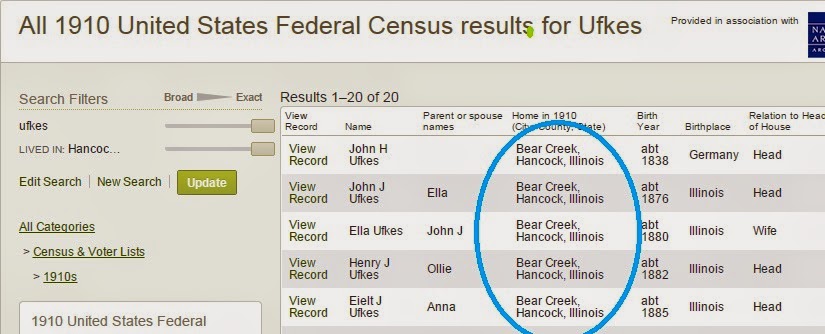[note: This originally appeared in the
Ancestry Daily News in January of 2001. There is still a lot of good food for thought in this piece.]
Genealogists ask questions of relatives, record keepers, librarians, family members, archivists, historians, and just about anyone who might have knowledge to assist them in their ancestral search. Family historians need to ask questions of others; after all, it's a great way to learn. But questions should not only be directed outward. Sometimes it is helpful if we ask a few questions of ourselves. Here are a few you should ponder.
YOU SAY: "I FOUND A NEW DOCUMENT TODAY."
And I wonder:
- Have you entered the information into your genealogy database?
- Have you completely analyzed the document?
- Have you thought about what other records the document suggests you
research?
- Have you filed the document so you can find it?
- Have you adequately cited the document so someone else can find the
original?
YOU SAY: "I HAVE A DOCUMENT I DON'T UNDERSTAND."
And I wonder:
- Have you read the document out loud?
- Have you typed the document?
- Have you asked someone else to look at the document?
- Have you read the entire document?
- Have you read the document backward?
- Have you looked up words you do not understand?
- Do you have the entire document?
- Do you have an incomplete transcription or abstract?
YOU SAY: "I CAN'T FIND WHERE MY ANCESTOR CAME FROM."
And I wonder:
- Have you looked at the entire family?
- Have you looked for unknown family members?
- Have you analyzed the neighbors?
- Have you read local histories?
- Have you read regional histories?
- Have you considered geography?
- Have you considered economics?
- Have you considered migration trails?
- Have you considered chain migration?
- Have you considered boundary changes?
- Have you traced the person's life as far as you can?
- Have you started with the most recent events and worked backward?
YOU SAY: "I'M STUCK."
And I wonder:
- Have you interviewed all the relatives?
- Have you interviewed former family neighbors?
- Have you identified all the family pictures?
- Have you considered all the spellings?
- Have you considered all the pronunciations?
- Have you taken a break and worked on another line or family?
- Have you written up what you already have?
Also:
- Have you CHECKED vital records?
- Have you checked LAND RECORDS?
- Have you checked court records?
- Have you checked probate records?
- Have you checked local records?
- Have you checked state records?
- Have you checked federal records?
- Have you checked church records?
- Have you checked occupational records?
- Have you checked ETHNIC organizations?
- Have you checked fraternal organizations?
- Have you researched every organization to which your ancestor
belonged (church, fraternal, ethnic, military, etc.)?
Furthermore:
- Have you checked your assumptions?
- Are you researching from the present to the past?
- Have you organized your information?
- Have you double-checked research you did when you were new to
genealogy?
- Have you put queries on appropriate bulletin boards?
- Have you posted your question to appropriate listservs?
YOU SAY: "I DON'T UNDERSTAND THIS TOPIC."
And I wonder:
- Have you attended a relevant workshop or seminar?
- Have you read an article or book on the subject?
- Have you listened to a conference tape?
- Have you read an appropriate reference work?
- Have you subscribed to an appropriate listserv?
- Have you looked for articles on the Internet?
YOU SAY: "I GOT IT OFF THE INTERNET."
And I wonder:
- Have you contacted the compiler?
- Have you located the original source?
- Have you located records the online source suggests?
- Have you considered that the online source might be incorrect?
- Have you considered using offline sources as well?
- Are you using the Internet source as a clue?
YOU SAY: "I CAN'T FIND IT IN THE INDEX."
And I wonder:
- Have you made certain you know how the index is compiled?
- Have you read the compiler's introduction (it might list record
problems)?
- Have you considered typographical errors?
- Have you considered transcription errors?
- Have you considered searching the records themselves?
YOU SAY: "I CAN'T FIND IT IN THE PUBLISHED SUMMARIES."
And I wonder:
- Have you considered reading the original records?
- Have you read the published material's preface?
YOU SAY: "I STARTED RESEARCH IN A NEW AREA."
And I wonder:
- Have you read research guides to that area?
- Have you located maps of that area?
- Have you contacted the local genealogical/historical society?
- Have you considered joining genealogy listservs for that area?
- Have you seen the USGenWeb page for that county?
- Have you seen the UsGenWeb page for that state?
- Have you checked Cyndi's List for that state?
- Do you understand the political boundaries of that area?
- Are you remembering that each area has different records?
- Are you remembering that each area may have different laws?
- Are you aware that each area has a different culture?
There are a lot of other things I could wonder too. This listing is
not meant to be comprehensive. However, if it makes you wonder about
your own research, then it has served its purpose. (After writing
this article, I realize I have a lot of work to catch up on as well!)
This post is:
http://rootdig.blogspot.com/2015/03/you-askand-i-wonder.html

























